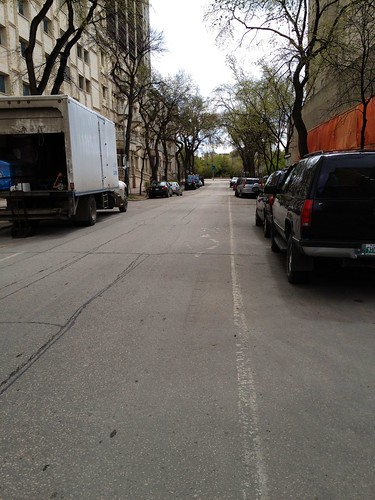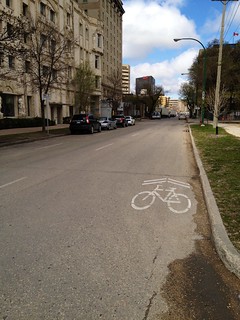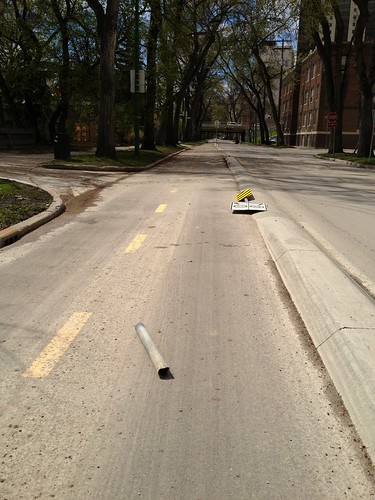Winnipeg
Osborne Bridge rehabilitation and bike lanes /

As many of you already know the Osborne Bridge is approximately halfway in to a rehabilitation project. The plans illustrate wider sidewalks, three Southbound lanes, two Northbound lanes, and bike lanes going both directions. When complete the City boasts that:
The plans do not however make mention of how the new design will accommodate cyclists, other than the included illustration of painted on bicycle lanes.
Personally I'm skeptical that the new design will make travel across the bridge any safer for cyclists. Painted on bike lanes can easily be ignored, and do not offer any real protection from motorists, particularly when we already have diamond lanes for buses and cyclists that are often abused by impatient motorists who are unwilling to wait in rush hour traffic.
I would have liked to see dedicated bike lanes, preferably on the same side of the barrier as the sidewalks to create a real division between faster traffic.
It seems to me as though Winnipeg squandered an opportunity to present a new generation of bike lanes and set the standard for other areas. As it stands there is a lack of consistency in bike lane design across the City. Even in the Downtown core there are multiple bike lanes. Assiniboine Ave. has it's dedicated bike path, Fort and Garry St. have painted bike lanes, and Portage / Broadway have no accommodations for cyclists at all.
Cities designed to be relevant in the future must start designing infrastructure with equal consideration for all types of traffic and stop treating pedestrians and cyclists as an afterthought.
Waterparks for everyone! /
Tuesday the City Council voted in favour of building a waterpark at the site just north of the Forks. Now word on the street (or Global News) is that there are already plans to construct a reportedly larger waterpark near the future IKEA. If this is true I hope it means the end of the downtown waterpark. Hopefully a developer will come forth with plans to build a waterpark near IKEA with their own money.
Honestly I don’t see the appeal of a waterpark in Downtown Winnipeg. Do you really want to strip down to a swimsuit and splash around with a bunch of rowdy kids when it’s 40 below? Who is the target waterpark patron? I doubt the Downtown residents will show much interest, certainly not the Waterfront Dr. condo crowd. Business would rely on families from the suburbs, families visiting from rural Manitoba, and out of province tourists.
The City’s justification for its 7 million dollar investment is the $700,000 worth of free admission tickets it will be allowed to distribute to lower income families. Is that really the type of social program Winnipeg needs? Will a waterpark as it has been promised be "a tremendous benefit to the city"?
I can’t help but draw comparisons between Winnipeg and the cartoon absurdities of Springfield. As Gregory Taylor has suggested, perhaps Lyle Lanley has moved on from monorail development and is now in business with Canalta and the waterpark lobby.
What an absurd city we live in.
My hope is that the IKEA waterpark will prove to be a better plan and require no (or less) government subsidization, which will free up the proposed site for a hopefully more suitable project, and the 7 million dollars for a more worthy cause.
Building up to tear down /
This week's episode of Winnipeg Internet Pundits is now online. They discuss the possibility of moving the CPR yards out of the city centre, speculate about Winnipeg's next tallest building, and plans for a new suburb.
I'll be joining them on UMFU for next Wednesday's show, where I'll continue to complain about transit and how I can never find anything to eat.
The Voice of North End Youth /
→ The FWD: North End Youth Newspaper
The mission of The FWD is to promote outreach, pride and involvement within the community and create a youth training /skill building opportunity in the form of a North End community newspaper. Based out of St. John’s, R.B. Russell, and Children of the Earth high schools, a weekly journalism club will offer guidance and training for students and a voice for community members. With the assistance of the organizational staff of The FWD, the members of the club will produce a product that reflects their community and allows them to establish relationships with community businesses and organizations while developing job readiness skills.
If you don't live or spend time in the North End you can get the PDF version of the paper on their site.
It would be great if they eventually started making The FWD available in other parts of the city to expose people to the real voices of the North End, rather than the headlines in the local crime column.
Mandatory helmet laws make me wonder if politicians haven't already sustained severe head trauma /
Jon Bovi, from the Winnipeg Free Press comments:
... mandatory helmet laws have clearly been shown to dissuade people from using bicycles as a mode of transportation, which is strictly contrary to the goal of encouraging a healthy lifestyle and reducing public medical costs.
I'm not going to argue that helmets don't prevent people from sustaining serious head injuries, however I argue that these injuries are less prevalent than the media and the medical health community would have you believe.
Since Manitoba has been toying with the idea of mandatory bicycle helmets I've heard all kinds of facts about how helmets save lives, though none of these articles mention the percentage of bicycle accidents that would have been prevented by wearing a helmet.
I've been in several bike accidents over the years, the most serious of which I broke several teeth and my nose, but did not sustain a "head" injury. I was not wearing a helmet and based on how I was injured (my face was impaled by the handlebars) a helmet wouldn't have made any difference.
But I digress, I realized that my own experiences are not an exact reflection of the rest of society. In many cases I don't doubt that people have been saved because they were wearing protective headwear. Helmets are probably a good idea, especially for young children, but should not be mandatory for several reasons.
As the commentor mentioned mandating helmets tends to discourage the everyday use of bicycles as a means of transportation. This is counterproductive for a society that needs to start weening itself off fossil fuels, and start seriously thinking about how people will get around in the cities of the future. Promoting simple, cheap, and accessible forms of transportation, such as the bicycle, is one of the most effective things we could be doing.
For evidence just look to the countries with the highest percentage of bicycle use.
France, Switzerland, Germany, the United Kingdom and Singapore do not impose any legislative requirements to mandate cyclists to wear protective helmets. Authorities in these countries generally consider that enhancing education and publicity to encourage voluntary wearing of protective helmets by cyclists is a more appropriate approach. In the United Kingdom, there are views that a mandatory requirement mayleadtoareductionincyclingactivities. Suchameasure may also not be generally accepted by the public, and there are practical difficulties in enforcement.
Another reason helmets should not be mandatory is that it is simply impossible to enforce such regulations. City Police and RCMP have higher priorities than chasing down cyclists who opt to take responsibility for their own safety. Even those pushing to make helmets mandatory admit that having the police enforce such laws is useless.
Jim Rondeau, Healthy Living Minister:
"We don't want to have police chasing kids to give them a ticket. What we're trying to do is look at innovative approaches."
How are mandatory helmet laws innovative?
An innovative approach would be an all incompasing plan for promoting bicycles, bike education, safe riding workshops, driver education (yes, motorist should be held accountable for cyclists safety!), and streets designed to make urban cycling safer, and while we're at it why don't we make the streets safer for pedestrians too (or maybe we can force them to wear helmets instead!)
Helmet laws, like so many other safety regulations, are a waste of resources, they don't work and they contribute to discouraging the very activities they attempt to make safer.


